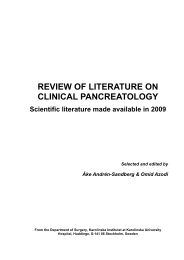Download PDF - The Pancreapedia
Download PDF - The Pancreapedia
Download PDF - The Pancreapedia
You also want an ePaper? Increase the reach of your titles
YUMPU automatically turns print PDFs into web optimized ePapers that Google loves.
Figure 39. <strong>The</strong> molecular structure of hamster pancreatic carcinogens.<br />
shorter latencies (41 to 52 weeks) than those in<br />
untreated hamsters (90 to 111 weeks) 77, 80 . Since<br />
neither DPN nor MPN affected the pancreas<br />
similarly, it was thought that substituted aliphatic<br />
chains in the β position are essential in the affinity<br />
for the pancreas. This assumption was<br />
substantiated by using<br />
N-nitrosobis(2-hydroxypropyl)amine (BHP) (Fig.<br />
39). After weekly subcutaneous injections of this<br />
compound at concentrations of 500, 250, or 125<br />
mg/kg body wt, a 100% pancreatic tumor<br />
incidence was obtained as early as 15 weeks<br />
after initiation of the treatment 148-152 . Grossly<br />
visible tumors were present in 51% of the cases<br />
measuring up to 20 mm in diameter. <strong>The</strong>se<br />
cancers had invaded the surrounding tissues and<br />
metastasized into the lung and liver. Like the<br />
parent compounds, DPN and MPN, BHP also<br />
induced respiratory tract tumors. Unlike the parent<br />
compound, BHP also produced liver tumors<br />
(hemangioendothelioma, angiosarcoma,<br />
cholangioma and carcinoma) as well as<br />
adenomas and adenocarcinomas of the kidney.<br />
36<br />
<strong>The</strong> results of these studies highlighted the<br />
existence of a relationship between the chemical<br />
structure of the nitrosamine and the target tissue.<br />
BHP not only preserved the carcinogenicity of the<br />
DPN in the respiratory tract, but also due to its β<br />
oxidation, primarily targeted the pancreas as well<br />
as the liver and kidney. Its potency to produce<br />
pancreatic carcinomas that morphologically and<br />
biologically were identical to human pancreatic<br />
cancers was remarkable. Since the induction of<br />
tumors in other tissues and in a high incidence<br />
restricted its value as a model for pancreatic<br />
cancer, several studies were set-up to minimize or<br />
ideally prevent tumor formation in tissues other<br />
than the pancreas. Modification of the BHP dose<br />
had limited success. A dose as low as 1/40 of the<br />
LD50 induced tumors primarily in the pancreas<br />
followed by the liver. Higher doses exhibited a<br />
more pronounced hepatocarcinogenicity and also<br />
induced tumors in the respiratory tract, gall<br />
bladder, kidney and vagina 153 . <strong>The</strong>se findings led<br />
Krüger to assume that the β position of the DPN<br />
chain determines its target tissue and the βoxidation<br />
of one chain could be more specific to<br />
the pancreas. Accordingly, he initially synthesized












